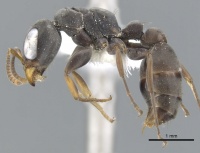Pseudomyrmex crudelis
| Pseudomyrmex crudelis | |
|---|---|

| |
| Scientific classification | |
| Kingdom: | Animalia |
| Phylum: | Arthropoda |
| Class: | Insecta |
| Order: | Hymenoptera |
| Family: | Formicidae |
| Subfamily: | Pseudomyrmecinae |
| Genus: | Pseudomyrmex |
| Species: | P. crudelis |
| Binomial name | |
| Pseudomyrmex crudelis Ward, 1999 | |
Known only from Tachigali growing in the western foothills of the Amazon basin. Workers keep pseudococcids as well as brood in the Tachigali domatia, and they are as aggressive in the defense of their nest sites as species in the P. viduus group (Ward 1999).
Identification
Ward (1999) - Workers and queens of P. crudelis are distinguished from other species in the sericeus group by the combination of medium size (worker HW 1.00–1.13, queen HW 1.13–1.22), relatively narrow worker head, and broad, subtrapezoidal petiole (worker DPW/HW 0.39–0.42, queen DPW/HW 0.49–0.52). The mesonotum of the male has an unusual anteromedial protrusion, not seen in any other Pseudomyrmex species.
Distribution
Latitudinal Distribution Pattern
Latitudinal Range: -6.3° to -6.3°.
| North Temperate |
North Subtropical |
Tropical | South Subtropical |
South Temperate |
- Source: AntMaps
Distribution based on Regional Taxon Lists
Neotropical Region: Peru (type locality).
Distribution based on AntMaps
Distribution based on AntWeb specimens
Check data from AntWeb
Countries Occupied
| Number of countries occupied by this species based on AntWiki Regional Taxon Lists. In general, fewer countries occupied indicates a narrower range, while more countries indicates a more widespread species. |

|
Estimated Abundance
| Relative abundance based on number of AntMaps records per species (this species within the purple bar). Fewer records (to the left) indicates a less abundant/encountered species while more records (to the right) indicates more abundant/encountered species. |

|
Biology
Castes
Nomenclature
The following information is derived from Barry Bolton's Online Catalogue of the Ants of the World.
- crudelis. Pseudomyrmex crudelis Ward, 1999b: 516, figs. 45, 54, 63 (w.q.m.) PERU.
Unless otherwise noted the text for the remainder of this section is reported from the publication that includes the original description.
Description
Worker
Measurements (n=10) HL 1.20–1.29, HW 1.00–1.13, MFC 0.024–0.053, LHT 0.81–0.93, CI 0.83–0.89, REL 0.59–0.62, REL2 0.68–0.73, FCI 0.02–0.05, FI 0.43–0.47, PLI 1.01–1.13, PWI 0.91–1.03.
A member of the sericeus group. Palp formula 6,4 (rarely 6p5,4). Frontal carinae moderately separated; eyes of short to medium length for the species group (see REL values). Head relatively elongate (CI < 0.90), the sides only weakly convex, the posterior margin slightly to moderately concave, in full-face view. Profemur moderately slender. Dorsal face of propodeum subequal in length to declivitous face, in profile the two faces meeting at a rounded angle. Petiole high and broad, with more or less differentiated anterior and dorsal faces, dorsal face rounding into steep posterior face. Anteroventral petiolar process prominent, with posteriorly-directed tooth. Standing pilosity sparse, typically one pair of long stout setae on the pronotal humeri, petiole and postpetiole, rarely on the propodeum. Dark brownish-black, the appendages lighter; mandibles, frontoclypeal complex and protibia yellowish-brown.
Type Material
Holotype worker. PERU, San Martın: 24 km NNE Tarapoto, 6°18'S, 76°16'W, 220 m, 23.viii.1986, ex Tachigali, P. S. Ward# 8705 (Museum of Comparative Zoology). HW 1.05, HL 1.24, EL 0.75, LHT 0.88, PL 0.45, PH 0.47.
Paratypes. Same data as holotype: series of workers queens, males (The Natural History Museum, Los Angeles County Museum of Natural History, MCZC, Museo de Historia Natural, Museu de Zoologia da Universidade de Sao Paulo, Philip S. Ward Collection, University of California, Davis).
References
- Ward, P. S. 1999b. Systematics, biogeography and host plant associations of the Pseudomyrmex viduus group (Hymenoptera: Formicidae), Triplaris- and Tachigali-inhabiting ants. Zool. J. Linn. Soc. 126: 451-540 (page 516, figs. 45, 54, 63 worker, queen, male described)
References based on Global Ant Biodiversity Informatics
- Bezdeckova K., P. Bedecka, and I. Machar. 2015. A checklist of the ants (Hymenoptera: Formicidae) of Peru. Zootaxa 4020 (1): 101–133.
- Brandao C. R. F., F. A. Esteves, and L. P. Prado. 2010. A catalogue of the Pseudomyrmecinae ant type specimens (Hymenoptera, Formicidae) deposited in the Museu de Zoologia da Universidade de Sao paulo, Brazil. Papeis Avulsos de Zoologia 50(45): 693-699.
- Fernández, F. and S. Sendoya. 2004. Lista de las hormigas neotropicales. Biota Colombiana Volume 5, Number 1.

